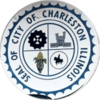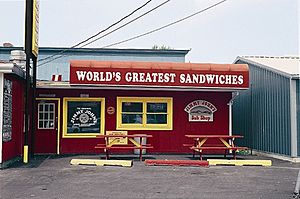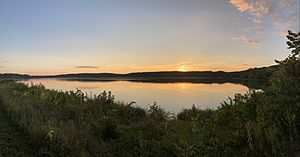Charleston, Illinois facts for kids
Quick facts for kids
Charleston, Illinois
|
|||
|---|---|---|---|
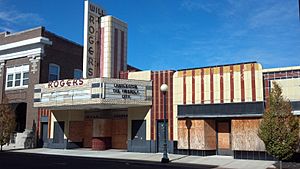
Will Rogers Theatre and Commercial Block
|
|||
|
|||
| Nickname(s):
Chucktown
|
|||
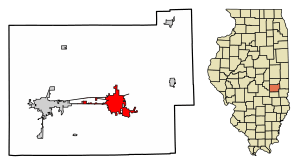
Location of Charleston in Coles County, Illinois.
|
|||
| Country | |||
| State | |||
| County | Coles | ||
| Townships | Charleston, Hutton, Lafayette, Seven Hickory | ||
| Founded | 1831 | ||
| Incorporation | 1865 | ||
| Founded by | Benjamin Parker | ||
| Named for | Charles Morton - Postmaster | ||
| Government | |||
| • Type | City Manager | ||
| Area | |||
| • Total | 9.59 sq mi (24.83 km2) | ||
| • Land | 8.88 sq mi (23.01 km2) | ||
| • Water | 0.70 sq mi (1.82 km2) | ||
| Elevation | 699 ft (213 m) | ||
| Population
(2020)
|
|||
| • Total | 17,286 | ||
| • Density | 1,945.75/sq mi (751.23/km2) | ||
| Time zone | UTC−6 (CST) | ||
| • Summer (DST) | UTC−5 (CDT) | ||
| ZIP Code(s) |
61920
|
||
| Area code(s) | 217, 447 | ||
| FIPS code | 17-12567 | ||
| GNIS ID | 2393803 | ||
| Wikimedia Commons | Charleston, Illinois | ||
Charleston is a city in Coles County, Illinois, in the United States. It's the main city of the county. In 2020, about 17,286 people lived there.
Charleston is special because it's home to Eastern Illinois University. It also has strong connections with its nearby city, Mattoon. Together, they form an important area called the Charleston–Mattoon Micropolitan Statistical Area.
Contents
History of Charleston
Long ago, Native Americans lived in the Charleston area for thousands of years. They lived here before the first European settlers arrived. The land was rich with tall prairie grasslands and beech-maple forests. The Embarras River and Wabash River were also nearby. This gave the Native Americans many resources.
Early settlers and Native Americans sometimes lived together peacefully. But there were also conflicts in the 1810s and 1820s. After some disagreements, battles took place south of Charleston. These conflicts didn't stop American settlers from moving in. By the 1840s, most Native Americans had left the area.
Founding and Early Years
Benjamin Parker was the first settler in Charleston in 1826. The city was named after Charles Morton, who was the first postmaster. Charleston was officially started in 1831 and became a city in 1865.
Abraham Lincoln's father moved to a farm near Charleston in 1831. Lincoln helped him move, then started his own life elsewhere. Lincoln often visited Charleston, especially the Coles County courthouse. One of the famous Lincoln–Douglas debates happened here on September 18, 1858. Today, this spot is part of the Coles County fairgrounds and has a small museum. Lincoln's last visit was in 1859 to see his stepmother and his father's grave.
Charleston During the Civil War
Even though Illinois was against slavery, many settlers in Coles County had come from the South. They had different views on slavery. In 1847, there was a disagreement when some people helped a family of escaped slaves. Abraham Lincoln, who was a lawyer then, argued in court about returning the escaped slaves.
During the American Civil War, these disagreements sometimes led to conflict. On March 28, 1864, there was a fight in downtown Charleston. It happened when some people who supported the Confederate side clashed with Union soldiers.
Eastern Illinois University Begins
In 1895, the Eastern Illinois State Normal School was created in Charleston. This school later became Eastern Illinois University. This made some people in nearby Mattoon upset. They had wanted the school to be built in their city.
Lincoln Log Cabin State Historic Site
Thomas Lincoln's (Abraham Lincoln's father) log cabin has been rebuilt. It is now open to the public as the Lincoln Log Cabin State Historic Site. It's about 8 miles south of Charleston. The Lincoln farm is like a living history museum. Here, actors show what life was like in Illinois in the 1840s. Thomas and Sarah Bush Lincoln are buried nearby.
1917 Tornado
On May 26, 1917, a strong tornado hit Charleston. It caused a lot of damage, destroying 220 homes.
Geography and Climate
Charleston covers about 9.59 square miles (24.83 square kilometers). Most of this area is land, and a small part is water.
Charleston's Weather
Charleston has a climate with warm summers and cold winters. Here's a quick look at the average temperatures and rainfall:
| Climate data for Charleston, Illinois (1991–2020 normals, extremes 1896–present) | |||||||||||||
|---|---|---|---|---|---|---|---|---|---|---|---|---|---|
| Month | Jan | Feb | Mar | Apr | May | Jun | Jul | Aug | Sep | Oct | Nov | Dec | Year |
| Record high °F (°C) | 71 (22) |
75 (24) |
89 (32) |
92 (33) |
101 (38) |
108 (42) |
110 (43) |
107 (42) |
104 (40) |
94 (34) |
84 (29) |
73 (23) |
110 (43) |
| Mean daily maximum °F (°C) | 37.9 (3.3) |
43.3 (6.3) |
54.3 (12.4) |
67.3 (19.6) |
77.1 (25.1) |
85.5 (29.7) |
88.1 (31.2) |
86.6 (30.3) |
81.2 (27.3) |
68.9 (20.5) |
54.4 (12.4) |
42.4 (5.8) |
65.6 (18.7) |
| Daily mean °F (°C) | 29.3 (−1.5) |
33.9 (1.1) |
44.0 (6.7) |
55.7 (13.2) |
65.6 (18.7) |
74.2 (23.4) |
77.2 (25.1) |
75.5 (24.2) |
69.0 (20.6) |
57.3 (14.1) |
44.6 (7.0) |
34.3 (1.3) |
55.0 (12.8) |
| Mean daily minimum °F (°C) | 20.7 (−6.3) |
24.6 (−4.1) |
33.6 (0.9) |
44.1 (6.7) |
54.1 (12.3) |
63.0 (17.2) |
66.2 (19.0) |
64.4 (18.0) |
56.8 (13.8) |
45.6 (7.6) |
34.9 (1.6) |
26.1 (−3.3) |
44.5 (6.9) |
| Record low °F (°C) | −27 (−33) |
−23 (−31) |
−14 (−26) |
14 (−10) |
26 (−3) |
35 (2) |
45 (7) |
39 (4) |
25 (−4) |
11 (−12) |
−2 (−19) |
−20 (−29) |
−27 (−33) |
| Average precipitation inches (mm) | 2.54 (65) |
2.69 (68) |
3.11 (79) |
5.09 (129) |
4.52 (115) |
4.84 (123) |
4.40 (112) |
2.94 (75) |
3.15 (80) |
3.94 (100) |
3.74 (95) |
2.79 (71) |
43.75 (1,111) |
| Average snowfall inches (cm) | 8.1 (21) |
5.5 (14) |
1.3 (3.3) |
0.3 (0.76) |
0.0 (0.0) |
0.0 (0.0) |
0.0 (0.0) |
0.0 (0.0) |
0.0 (0.0) |
0.0 (0.0) |
0.8 (2.0) |
3.0 (7.6) |
19.0 (48) |
| Average precipitation days (≥ 0.01 in) | 10.2 | 8.3 | 10.7 | 12.0 | 12.9 | 10.4 | 9.2 | 8.1 | 7.8 | 9.5 | 10.4 | 10.6 | 120.2 |
| Average snowy days (≥ 0.1 in) | 4.1 | 2.6 | 1.4 | 0.1 | 0.0 | 0.0 | 0.0 | 0.0 | 0.0 | 0.0 | 0.5 | 3.2 | 11.9 |
| Source: NOAA | |||||||||||||
People of Charleston
| Historical population | |||
|---|---|---|---|
| Census | Pop. | %± | |
| 1850 | 849 | — | |
| 1870 | 2,849 | — | |
| 1880 | 2,867 | 0.6% | |
| 1890 | 4,135 | 44.2% | |
| 1900 | 5,488 | 32.7% | |
| 1910 | 5,884 | 7.2% | |
| 1920 | 6,615 | 12.4% | |
| 1930 | 8,012 | 21.1% | |
| 1940 | 8,197 | 2.3% | |
| 1950 | 9,164 | 11.8% | |
| 1960 | 10,505 | 14.6% | |
| 1970 | 16,421 | 56.3% | |
| 1980 | 19,355 | 17.9% | |
| 1990 | 20,398 | 5.4% | |
| 2000 | 21,039 | 3.1% | |
| 2010 | 21,838 | 3.8% | |
| 2020 | 17,286 | −20.8% | |
| U.S. Decennial Census | |||
In 2020, Charleston had 17,286 people living there. There were 7,847 households and 3,850 families. The city had about 1,803 people per square mile.
Most people in Charleston (about 79.65%) were White. About 8.39% were African American, and 2.54% were Asian. People of Hispanic or Latino background made up 5.84% of the population.
About 12.7% of the people were under 18 years old. A large group, 32.5%, were between 18 and 24 years old. The average age in Charleston was 27.7 years.
Economy and Jobs
Charleston's economy is strongly linked to Eastern Illinois University. The university has about 8,600 students. It also hosts state finals for high school badminton, journalism, and track and field.
The city has an "enterprise zone" that helps bring in manufacturing jobs. Companies like Vesuvius USA and ITW Hi-Cone have facilities here.
Did you know that the first ever Jimmy John's sandwich shop started in Charleston? Jimmy John Liautaud opened it in 1983.
Fun Things to Do
Charleston hosts the annual Coles County Fair every summer. It's a week-long event with animal shows, carnival rides, and a demolition derby. The fair is held at the fairgrounds on W Madison Ave.
Museums and Libraries
- Charleston Carnegie Public Library
- EIU Tarble Arts Center
- Doudna Fine Arts Center
- Lincoln Douglas Debate Museum
- Five Mile House
Parks and Outdoor Activities
Charleston has seven parks and six trails for outdoor fun.
Lake Charleston
Lake Charleston is about two miles (3 km) southeast of the city. It's a big lake, covering 330 acres. You can go fishing and boating there, but boats must go slowly. There are five trails around the lake, with the longest one being 3.6 miles (5.8 km) long.
List of Parks
- Fox Ridge State Park
- Morton Park
- Sister City Park
- Kiwanis Park
- North Park
- VFW Way Park
- Reasor Park
Parks and Recreation Department
Charleston's Parks and Recreation Department offers many activities. These include before and after school clubs, dog training, and sports leagues for kids.
Education in Charleston
Charleston is part of the Charleston Community Unit School District 1. This district has six schools:
- Ashmore Elementary School (PreK-4)
- Mark Twain Elementary School (PreK and K)
- Carl Sandburg Elementary School (1-3)
- Jefferson Elementary School (4-6)
- Charleston Middle School (7-8)
- Charleston High School (9-12)
Eastern Illinois University is a public university in Charleston. It has been serving the community since 1895. Lakeview College of Nursing also has a campus here.
News and Media
Charleston has a local newspaper called the JG-TC (Journal Gazette & Times Courier). Eastern Illinois University also has its own daily newspaper, The Daily Eastern News.
Getting Around Charleston
Charleston is about 7 miles (11 km) east of Interstate 57. Illinois Route 16 is the main east-west road in the city, known as Lincoln Ave.
Main Roads
- Illinois Route 16 (Lincoln Ave.)
- Illinois Route 130 (18th St./Olive Ave.)
- Illinois Route 316 (Madison Ave./State St.)
Airport Access
The Coles County Memorial Airport (MTO) serves Charleston. It's about 6 miles (10 km) west of the city. It used to have commercial flights but now mainly serves smaller planes.
Public Transportation
Charleston has two public transport options:
- The Charleston Zipline (run by Dial-A-Ride) offers bus service around the city.
- The Panther Shuttle mainly serves the Eastern Illinois University campus.
Train Service
Charleston does not have direct passenger train service. However, you can catch Amtrak trains like the Illini and Saluki and City of New Orleans in nearby Mattoon.
Healthcare Services
Charleston is served by the Sarah Bush Lincoln Health Center. Its main hospital is about 6 miles (10 km) west of Charleston. There is also a Walk-In Clinic right in the city.
Famous People from Charleston
- Kim Chizevsky-Nicholls, a professional bodybuilder.
- Jim Edgar, who was the governor of Illinois from 1990 to 1998. He grew up in Charleston.
- James John Liautaud, who started the Jimmy John's restaurant chain.
- Marty Pattin, a former professional baseball pitcher.
- Curtis Price, a professor of music and head of the Royal Academy of Music.
- Gregg Toland, a famous cinematographer who won an Oscar. He was born and raised in Charleston.
See also
 In Spanish: Charleston (Illinois) para niños
In Spanish: Charleston (Illinois) para niños



